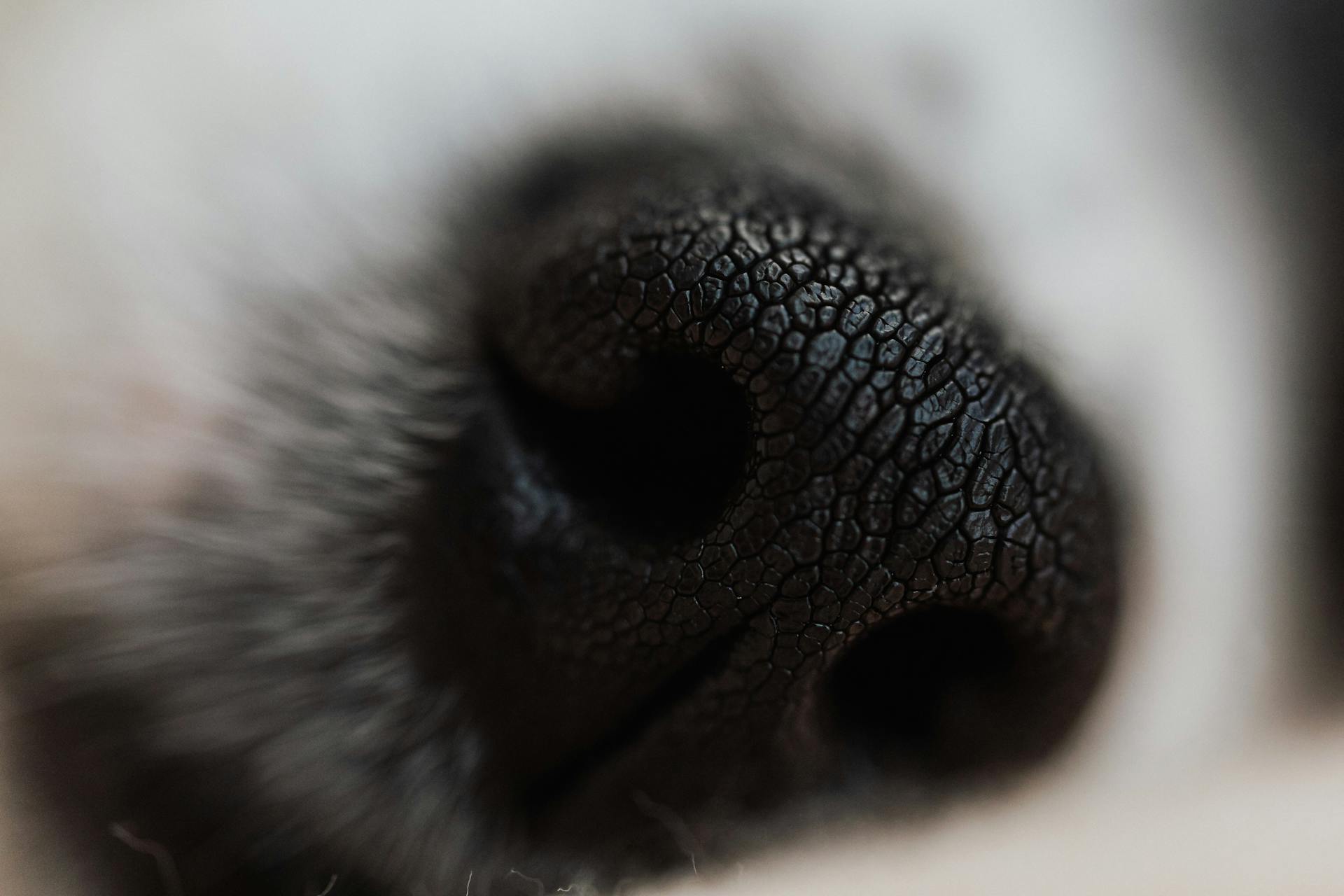
Interdigital cysts in Labradors are a common issue that can cause discomfort and pain for your furry friend. Typically, they appear between the toes.
Labradors are prone to interdigital cysts due to their webbed feet, which can trap moisture and create an ideal environment for bacterial growth. Interdigital cysts are often caused by bacterial infections.
Symptoms of interdigital cysts in Labradors can include redness, swelling, and discharge between the toes. In severe cases, the cysts can become painful and infected.
Interdigital cysts are usually diagnosed through a physical examination and may require a biopsy to confirm the diagnosis.
For more insights, see: Bacterial Pyoderma Hypothyroidism in Dogs Skin Problems
What Are Interdigital Cysts?
Interdigital cysts are painful and inflamed tissue in the webbing between a dog's toes. They're not true cysts, but rather lesions that can be quite uncomfortable for your furry friend.
These cysts or furuncles, as they're also called, are most commonly found on the top of the front feet. However, all four feet can be affected, and the webbing between the toes has little space to spread, so the furuncle often ruptures through the skin and produces a draining tract.
For your interest: Types of Dog Cysts
Any dog can develop interdigital cysts, but some breeds are more prone to them. If your Labrador is short-haired, allergy-prone, overweight, or obese, they're more likely to develop interdigital cysts.
Certain breeds have a higher risk of developing interdigital cysts due to their physical characteristics. These include breeds with short bristly hairs in the webbing and increased webbing between the toes.
Here are some breeds that are more likely to get interdigital cysts:
- Shar-Pei
- Labrador Retriever
- English Bulldog
- Mastiff
- Great Dane
- Boxer
- Basset Hound
Symptoms and Signs
If your Labrador is developing interdigital cysts, you'll likely notice raised red bumps between their toes. These bumps can be painful and may cause your dog to lick or chew at their feet more than usual.
Interdigital cysts can also lead to discoloured paws, especially if there's a secondary infection. You may even spot small blood spots on the floor if a cyst has ruptured.
Dogs with interdigital cysts often exhibit painful behavior, such as limping or being reluctant to walk. This is because the cysts can be quite painful.
Curious to learn more? Check out: Cysts on Shih Tzu Dogs
Here are some common signs of interdigital cysts in Labradors:
- Bumpy, red welts in the webbing between your dog's toes (interdigital)
- Fleshy or ulcerated sore or wound
- Hairless bumps between the toes
- Redness, inflammation
- Bleeding and itching
- Fluids, blood or pus
- Recurrent skin infections on the hairy skin of the paws
- Limping or not walking normally, difficult for paws to bear weight
It's essential to address these symptoms promptly to prevent further complications, such as secondary infections or skin infections.
Diagnosis
Diagnosis is a crucial step in treating interdigital cysts in Labradors. A veterinarian will perform a physical examination to inspect the interdigital skin between the toes, looking for signs of inflammation, swelling, redness, and painful lesions or nodules.
The veterinarian may also conduct skin tests to rule out Demodex mites or other parasitic infections. Impression Smears or a skin scrape can help determine the presence of bacteria.
A skin biopsy may be recommended to confirm the diagnosis and rule out more serious conditions like tumours or follicular cysts. Your veterinarian may also take a sample from the cystic area for bacterial culture and sensitivity testing.
Here's an overview of the diagnostic process:
Your veterinarian may also perform an aspiration or Fine Needle Aspiration (FNA) to extract a small sample of fluid or tissue from the cyst. This sample is then examined under a microscope to confirm the presence of inflammatory cells or other relevant indicators.
Treatment of
Treatment of interdigital cysts in Labradors involves addressing the underlying cause, which can be a complex process.
The goal of treatment is to control the underlying cause, whether it's an allergy, infection, or autoimmune condition, and to promote healing and prevent future occurrences.
Medical therapy is often the first line of defense, involving topical treatments like steroid ointments and antimicrobial paw soaks to manage superficial inflammation and infection.
Oral medications, such as antibiotics and antifungal medications, may be prescribed to address bacterial or fungal infections.
In severe cases, immunosuppressive medications may be prescribed to manage autoimmune conditions.
Surgery may be necessary in some cases, particularly if the cyst is persistent or recurrent, to prevent future recurrence.
Here are some common treatment options for interdigital cysts in Labradors:
- Medical therapy: This can include topical treatments, oral medications, and immunosuppressive medications.
- Surgery: This may involve incision and drainage or excision of the cyst.
- CO2 laser therapy: This can be used to remove unhealthy skin layers with minimal damage to the surrounding area.
It's essential to work closely with a veterinarian to determine the best course of treatment for your Labrador and to develop a long-term management plan to prevent future occurrences.
Recovery and Prevention
Recovery from interdigital cysts in Labradors can take months, and it's essential to manage the underlying cause of the trauma to achieve complete resolution.
Factors like wet, hard, or uneven environments, dirty kennels, or uncontrolled allergies can prevent complete resolution of interdigital cysts, so addressing these issues is crucial.
Lifelong routine management is required to maintain remission, and in most cases, medication to moderate the immune system's response to environmental trauma is needed for long-term control.
The affected area should be free from discomfort, swelling, and signs of inflammation for a successful recovery.
Keeping the paws clean is a preventative measure against further infections, and regular paw care, including cleaning and inspection, can also prevent future occurrences.
In chronic cases of interdigital cysts, successful recovery may require long-term treatment and management, which could involve ongoing medication, regular veterinary check-ups, and proactive measures to address any contributing factors.
Pet insurance, like Waggel's Lifetime policy, can help manage chronic conditions by offering financial support, consistent care for your pet's lifetime, and peace of mind.
Intriguing read: How Long Do English Labradors Live
Medications and Therapy
Medications are often the first line of defense for interdigital cysts in Labradors. Steroids or antibiotics are usually prescribed together, which can be given orally or topically.
Topical treatment is a good choice for minor issues, while more serious cases may require oral medication to address the infection systemically. Your veterinarian may ask you to wipe your dog's paws often with medicated cloths.
Oral medications can include antibiotics to address bacterial infections, antifungal medications for fungal infections, and nonsteroidal anti-inflammatory drugs (NSAIDs) to manage pain and inflammation. Allergy medication may also be prescribed if allergies are diagnosed as the underlying cause.
Here is a summary of common oral medications:
Medical Therapy
Medical therapy for interdigital cysts can involve a variety of treatments to alleviate symptoms and promote healing. Topical treatments are often the first line of defense, using ointments or creams to reduce inflammation and promote healing.
Topical treatments can include antibacterial or antifungal ointments applied directly to the cyst. Applying a Skin Soother can also aid in relief.

Oral medications may be prescribed to address bacterial or fungal infections. Antibiotics are often given in courses to ensure the infection is fully cleared. Antifungal medications can also be administered to address fungal infections.
In some cases, nonsteroidal anti-inflammatory drugs (NSAIDs) may be recommended to manage pain and inflammation. Allergy medication might also be prescribed if allergies are diagnosed as the underlying cause.
Immunosuppressive medications may be prescribed in severe cases, especially if the cysts are related to autoimmune conditions.
For another approach, see: Fungal Skin Disorders in Dogs
Laser Therapy
Laser Therapy can be a viable option for treating paw cysts in dogs, as a CO2 laser can vaporize the affected tissue without altering the normal paw structure.
This treatment can be effective, but it may require multiple sessions.
If your dog experiences repeated occurrences of paw cysts, it's essential to investigate deeper to rule out underlying issues such as allergies or sensitivities.
Frequently Asked Questions
How do you get rid of an interdigital cyst on a dog?
Interdigital cysts in dogs can be treated with surgery, CO2 laser therapy, or medication, depending on the severity and location of the cyst
Will an interdigital cyst go away on its own?
Interdigital cysts can often heal on their own with proper treatment, especially when caught early. However, early intervention and treatment are key to preventing complications and promoting a full recovery.
How much does it cost to treat an interdigital cyst on a dog?
Treatment costs for an interdigital cyst on a dog can range from $200 to $1,000, depending on the course of treatment and your pet's health. Learn more about the factors that influence the cost of treatment.
Are interdigital cysts on dogs cancerous?
No, interdigital cysts on dogs are not cancerous, but a biopsy is needed to confirm the diagnosis. Consult a vet for a proper evaluation and diagnosis.
Why does my dog have a lump in between his toes?
Lumps between a dog's toes can be caused by cysts or comedones, which are clogged hair follicles or pockets of fluid under the skin
Sources
- https://vcahospitals.com/know-your-pet/interdigital-cysts-in-dogs
- https://www.petmd.com/dog/conditions/skin/interdigital-cysts-dogs
- https://www.medvet.com/interdigital-folliculitis-and-furunculosis-interdigital-cysts/
- https://www.dogsnaturallymagazine.com/home-remedies-for-your-dogs-interdigital-cysts/
- https://www.waggel.co.uk/blog/post/interdigital-cysts-in-dogs
Featured Images: pexels.com


